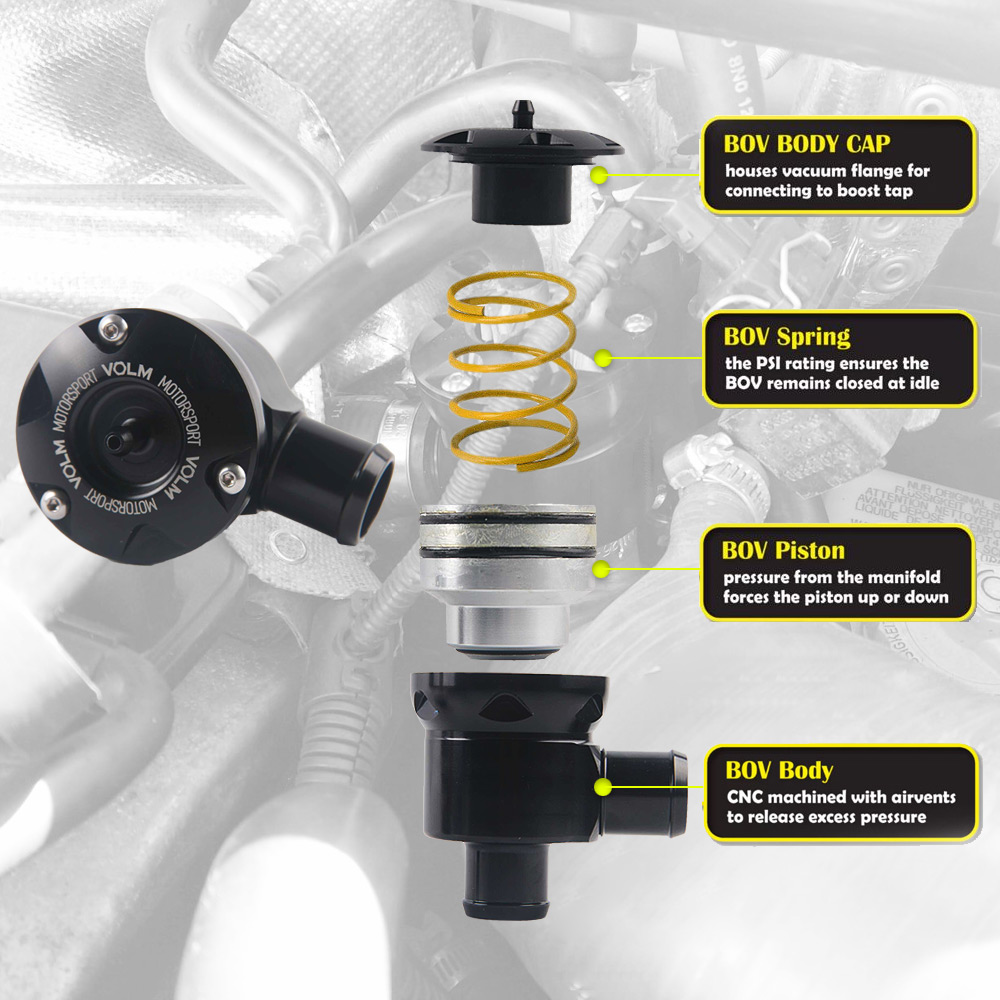Article Navigation
A simple guide to BLOW OFF VALVE
What is a Blow Off Valve?
A Blow Off Valve (BOV) is a crucial component in turbocharged engines. It is designed to release excess pressure from the intake system to prevent compressor surge, which can damage the turbocharger. When the throttle is closed, the BOV vents the built-up pressure, either to the atmosphere or back into the intake system.
Location of the Blow Off Valve
The BOV is typically located on the intake side of a turbocharged engine, between the turbocharger and the throttle body. Its exact placement can vary depending on the vehicle’s design, but it is generally positioned in a way that it can effectively release pressure when the throttle is closed.
What does a Blow Off Valve do?
Blow Off Valve Benefits
- Prevents Compressor Surge: Protects the turbocharger from damage by releasing excess pressure.
- Improves Throttle Response: Enhances driving experience by reducing lag during gear changes.
- Extends Turbo Life: By reducing stress on the turbocharger, it helps in prolonging its lifespan.
Blow Off Valve Disadvantages
- Noise: Some BOVs can be quite loud, which might be undesirable for daily drivers.
- Potential for Leaks: If not installed properly, BOVs can cause air leaks, leading to performance issues.
- Legal Issues: In some regions, vent-to-atmosphere BOVs might be illegal due to noise regulations.
Blow Off Valve Detail
A typical BOV consists of the following parts:
- Valve Body: The main structure housing the internal components.
- Piston or Diaphragm: Moves in response to pressure changes, opening and closing the valve.
- Spring: Determines the pressure at which the valve opens.
- Vacuum Line: Connects to the intake manifold to sense pressure changes.
Common Types of Blow Off Valves
The Sound of a Blow Off Valve
The sound of a BOV is one of its most distinctive characteristics. Vent-to-atmosphere BOVs are known for their loud hissing or whooshing noise, which can be a draw for performance enthusiasts. Recirculating BOVs are much quieter, making them a better choice for those who prefer less noise.
Symptoms of a Bad Blow Off Valve
A malfunctioning BOV can lead to several issues. Here are common symptoms:
- Compressor Surge: If the BOV fails to release pressure, you may hear a fluttering noise when letting off the throttle.
- Poor Throttle Response: A stuck or leaking BOV can cause hesitation or sluggish throttle response.
- Reduced Boost Pressure: Leaks in the BOV can lead to a drop in boost pressure, resulting in decreased engine performance.
- Check Engine Light: Some vehicles may trigger a check engine light if the BOV is not functioning correctly.
- Whistling or Hissing Sounds: Continuous or abnormal noises when the throttle is closed can indicate a problem.
Does a Blow Off Valve Increase Horsepower?
A BOV itself does not directly increase horsepower. However, it can improve the overall efficiency and longevity of a turbocharged system by preventing compressor surge and maintaining better throttle response. This can result in a smoother driving experience and potentially optimize the performance gains provided by other modifications.
Does a Blow Off Valve Void Warranty?
Whether a BOV will void your vehicle’s warranty depends on several factors:
- Manufacturer’s Policy: Some manufacturers may void the warranty if they determine that the aftermarket BOV has caused damage or affected the vehicle’s performance.
- Installation Quality: Proper installation by a professional can reduce the risk of warranty issues. Incorrect installation can lead to engine problems, which might void the warranty.
- Vehicle Usage: Using the vehicle in a manner not intended by the manufacturer (e.g., racing) can also void the warranty.
It’s best to check your vehicle’s warranty policy and consult with the manufacturer or dealership before installing a BOV.
Blow Off Valve Cost
The cost of a BOV can vary widely based on the brand, type, and vehicle compatibility. Here’s a general price range:
- Entry-Level BOVs: $50 to $150. These are basic models suitable for light use and moderate performance improvements.
- Mid-Range BOVs: $150 to $300. These offer better materials, adjustability, and are suitable for most enthusiasts.
- High-End BOVs: $300 to $600+. These top-tier models provide superior performance, advanced features, and are often used in high-performance or racing applications.
Future Developments in Blow Off Valve
The future of BOV technology looks promising, with advancements focusing on:
- Improved Materials: Using lightweight and durable materials to enhance performance and longevity.
- Electronics Integration: Incorporating electronic controls for more precise valve operation.
- Noise Reduction: Developing quieter designs to comply with stricter noise regulations without sacrificing performance.
Conclusion
Blow Off Valves are essential for maintaining the health and performance of turbocharged engines. Understanding their function, advantages, types, and legal considerations can help you make an informed decision about whether to install one in your vehicle. As technology advances, we can expect even more efficient and user-friendly BOVs in the market.
We’ll be posting more articles soon. If you’re interested, drop us a message and let us know! (The article was edited by ChatGPT and is for reference only. Please consult your local laws and regulations and your mechanic for specific questions.)







